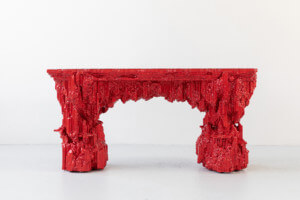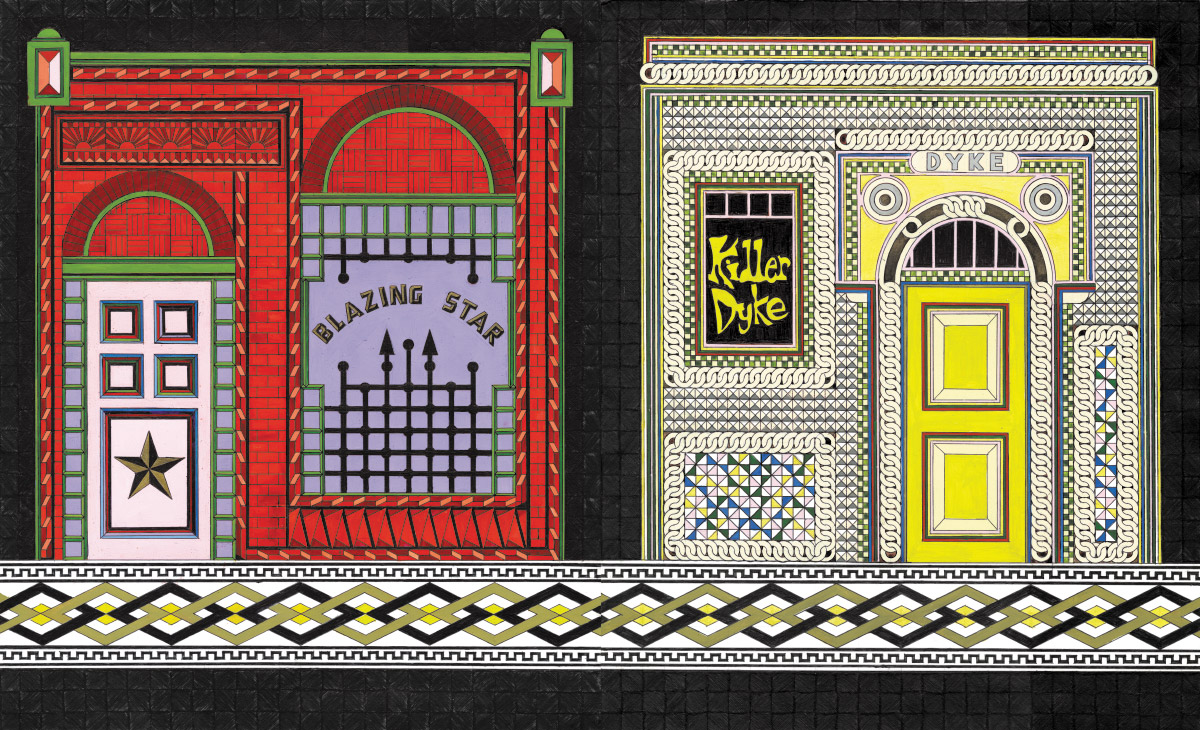You may think you know wood, but this exhibition stretches the material beyond convention into the 21st century, and has a distinct sense of humor. Artists and designers play with the form, starting with artist Martin Puryear, who inspired curator Lowery Sims to explore trends that destabilize conventional methods. His specially commissioned piece for this show is a puffy, tufted wing-back chair that looks so soft you could sink into it, but it is actually solid pine. Its title, A Skeuomorphic Wing Chair, 2012, refers to the ersatz, an object made to resemble another material to make the new look comfortably old and familiar, like a digital notebook app that mimics yellow lined paper. Weight is conveyed differently in Yuya Ushida’s Sofa_XXXX, 2010, a delicate lattice comprised of 8,000 recycled bamboo chopsticks, that can be expanded or contracted; or Mark Moskovitz’s Facecord, 2012, which looks like a stockpiled cord of logs, but is actually a chest of drawers.
Seating figures prominently in this exhibition in a variety of guises. A skyscraper sits on a chair. While this is impossible physically, Alexandre Arrechea, a Los Carpinteros alumnus (the Cuban arts collective), has created this intentional instability and called it Conspiracy, 2007, to comment on issues of power, surveillance, and control. With its strong dark and light striped patterns, the work feels playful at the same time, reminiscent of Arrechea’s spring 2013 installation, No Limits in the Park Avenue median strips of iconic New York buildings including the Chrysler and Empire State Building as the wriggling tips of a coiled hose and snake, the Flatiron as a flag on a pole, and the Helmsley Building in a circle eating its own tail.
Tea Ceremony Chair, 2010, by Hiroki Takada sports impossibly tall shoots. Gary Carsley’s D.100Wave Hill (Tree Struck by Lightning), 2012, sets tree-photographed contact-papered Ikea chairs against a background of the same images, virtually camouflaging the furniture; similarly, Piet Hein Eek shows chairs and wallpaper in the same scavenged wood to create trompe l’oeil Scrapwood Wallpaper and Oak Chair in Scrapwood.
New interpretations of Thonet, the maestro of bentwood, delight. From Matthias Pliessnig’s Thonet No. 18, 2007, a dynamic warren of tangled oak overlaying Thonet’s classic No. 18 chair buried beneath; to Christopher Kurtz’s A(typical) Windsor Form, 2004, which comingle the backs of two chairs much like Marina Abromovic’s hair conjoined with Ulay’s in Relation in Time, 1977; to the delightful Thoneteando video by Pablo Reinoso, where a woman does battle with a suite of No 18s, which are accompanied in a display nearby by footwear called Prêt-à-Thonet, 2007, and Two for Tango, Fontainebleau Suite, 2012, a pair of picture frames locked together with bentwood tentacles.
In a nod to the architectural, Hope Sandrow constructed Coop LeWitt North, 2012. Inspired by an actual chicken coop, she used a Sol Lewitt drawing like a blueprint, giving it dimensionality and functionality. Sarah Oppenheimer’s site-specific aperture is an architectural anomaly that navigates constructed space, in this case, an interior wall of the gallery. The wooden corner oblong frames views of the adjacent galleries. Alison Elizabeth Taylor’s marquetry is installed on the ceiling, folding onto the adjacent walls, as well as on the floor, using semi-demolished, decaying architectural elements that exploit the illusionistic potential of this technique. Traffic, 2009, by Hunt Clark, is a video projection of street traffic projected onto a smooth, undulating free-style blob that makes you want to get stuck in a traffic snarl.
The building is enlivened by an installation suspended from the ground floor lobby ceiling. A torqued ring of interlocked ready-made chairs is entitled Year and a Day, which has a double meaning: in medieval Europe, an escaped serf who remained a fugitive for this time period became free by law; and it is the time required for one revolution of the Earth around the sun on its own axis. Artist Marc Andre Robinson says chairs “stand for a choice: a choice to rest, to reflect, to stand, to author, and even rebel,” and a year and a day “is a record of a type of movement that begins as a benign measurement of time, but somehow ends in liberation.”










